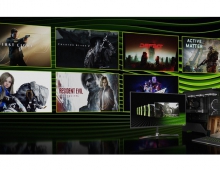
Nvidia Misses CES Launch Of The First Fermi-based GeForce Cards
Nvidia will delay its next-generation DirectX 11-supporting GPU (Fermi) to March, 2010, according to sources from graphics card makers.
Nvidia'a Fermi GPUs were originally scheduled to launch in November 2009, but was delayed until CES in January 2010 due to defects. However, the company recently notified graphics card makers that the official launch will now be in March 2010, the Digitimes.com web site reported today citing sources in Taiwan.
Nvidia is expected to launch a 40nm GDDR5 memory-based Fermi-GF100 GPU in March, and will launch a GF104 version in the second quarter to target the high-end market with its GeForce GTX295/285/275/260. The company has already posted some pictures of the upcoming Fermi-GF100 GP card on its Facebook page. The GF100 is the codename for the first GeForce GPU based on the Fermi architecture.
The company has delayed the introduction of its first DirectX 11 GPU, while rival AMD has already relesed its Radeon HD 5800 solutions five month ago.
For performance level markets, Nvidia is expected to position its updated GeForce GTS250, GT240/220 and 9800GT/9500GT defend against AMD's Radeon HD 5770/5750, 4870/4850 and 4670/4650.
The first Fermi based GPU for desktop is expected to be implemented with 3.0 billion transistors, will feature up to 512 SPEs, organized in 16 SMs of 32 cores each. Each SM has a fully pipelined integer arithmetic logic unit (ALU) and floating point unit (FPU). The GPU has six 64-bit memory partitions, for a 384-bit memory interface, supporting GDDR5 DRAM memory.
The new Fermi chip will be made using 40nm process technology at TSMC, which had reportedly been facing low 40nm process yields. According to the latest information, although the yields have been improved, capacity is still not sufficient to supply the two GPU giants fully (AMD, Nvidia).
On the other hand, AMD is expected to launch 40nm Radeon HD 5670/5570 (Redwood) and HD 5450 (Cedar) GPUs at the end of January or in February 2010.
A few days ago, NVIDIA downplayed AMD's lead in the DirectX 11 products, claiming that DirectX 11 would not stimulate sales of graphics cards.
"To us, being out of sync with the API for a couple of months isn?t as important as what we?re trying to do in the big scheme of things for the next four or five years. We?re just around the corner from preparing our next GeForce and the experience of what you?ll see in 3D, what you?ll feel in physics, and the improvements you get in graphics will be obvious to the market,? said Michael Hara, senior vice president of investor relations and communications of NVIDIA, at the Barclays Capital Global Technology Conference held mid of December..
"We go through revolutionary changes every three or four years, and that?s exactly where we?re at today? The next big evolution in the API world has come with DirectX 11, but we believe that?s a part of the experience," Hara said, adding that other technologies, including 3D stereo and physics, are also important.
"We?re almost there? In Q1, the world will get to see what we?ve done with Fermi."

Nvidia is expected to launch a 40nm GDDR5 memory-based Fermi-GF100 GPU in March, and will launch a GF104 version in the second quarter to target the high-end market with its GeForce GTX295/285/275/260. The company has already posted some pictures of the upcoming Fermi-GF100 GP card on its Facebook page. The GF100 is the codename for the first GeForce GPU based on the Fermi architecture.
The company has delayed the introduction of its first DirectX 11 GPU, while rival AMD has already relesed its Radeon HD 5800 solutions five month ago.
For performance level markets, Nvidia is expected to position its updated GeForce GTS250, GT240/220 and 9800GT/9500GT defend against AMD's Radeon HD 5770/5750, 4870/4850 and 4670/4650.
The first Fermi based GPU for desktop is expected to be implemented with 3.0 billion transistors, will feature up to 512 SPEs, organized in 16 SMs of 32 cores each. Each SM has a fully pipelined integer arithmetic logic unit (ALU) and floating point unit (FPU). The GPU has six 64-bit memory partitions, for a 384-bit memory interface, supporting GDDR5 DRAM memory.
The new Fermi chip will be made using 40nm process technology at TSMC, which had reportedly been facing low 40nm process yields. According to the latest information, although the yields have been improved, capacity is still not sufficient to supply the two GPU giants fully (AMD, Nvidia).
On the other hand, AMD is expected to launch 40nm Radeon HD 5670/5570 (Redwood) and HD 5450 (Cedar) GPUs at the end of January or in February 2010.
A few days ago, NVIDIA downplayed AMD's lead in the DirectX 11 products, claiming that DirectX 11 would not stimulate sales of graphics cards.
"To us, being out of sync with the API for a couple of months isn?t as important as what we?re trying to do in the big scheme of things for the next four or five years. We?re just around the corner from preparing our next GeForce and the experience of what you?ll see in 3D, what you?ll feel in physics, and the improvements you get in graphics will be obvious to the market,? said Michael Hara, senior vice president of investor relations and communications of NVIDIA, at the Barclays Capital Global Technology Conference held mid of December..
"We go through revolutionary changes every three or four years, and that?s exactly where we?re at today? The next big evolution in the API world has come with DirectX 11, but we believe that?s a part of the experience," Hara said, adding that other technologies, including 3D stereo and physics, are also important.
"We?re almost there? In Q1, the world will get to see what we?ve done with Fermi."






















